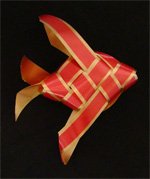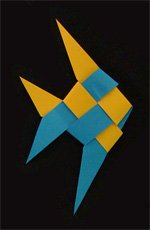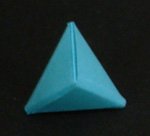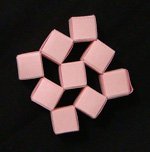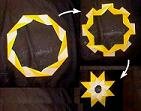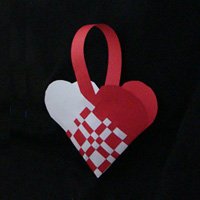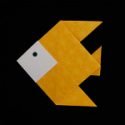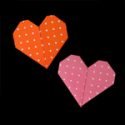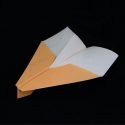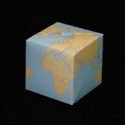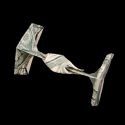Strip Folding
Strip folding can be call “origami fringe” because it is a combination of paper folding and paper weaving. Nevertheless, many origami enthusiasts have embraced this form of paper art. In fact, some people include palm weaving in this genre of art.
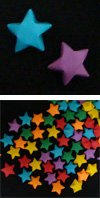
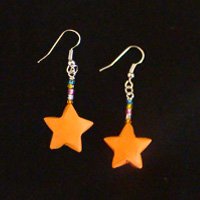
Lucky Stars
Probably, the easiest and most well known example of strip folding is the Lucky Star. It is also called Chinese lucky star, dream star, wishing star, or simply origami star. When they are made in a variety of colors and arranged in layers, or set in clear glass bowls, they are visually stunning.
You can thread them into earrings & necklaces or use them as decorative packing peanuts. Lucky Stars can be strung together to make garland or serve as a beaded curtain of stars. A jar of lucky stars can be used as a guessing game similar to guessing the number of jelly beans in a jar. Many people, especially children, have been known to sit and fold hundreds of them: it can be a meditative process.
Though not as popular, a similar method of strip folding can be used to make Lucky Hearts (see below).
- get diagrams to fold a lucky star here or here
- watch video by katsner
- buy pre-cut strips of paper to make lucky stars
- more fun things you can do with Lucky Stars
- comic strip featuring Lucky Stars
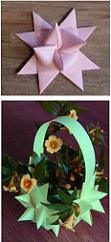
Moravian Stars
Moravian stars are also called: Froebel stars, German stars, Swedish stars, Polish star, Danish star, and other names such as origami star, or Christmas stars.
Historically the term Moravian star refers to a 3-dimensional spikey star that is illuminated during Advent and/or Christmas (particularly by Germans and people of Moravian descent). The original Moravian stars had 110 spikes but later a simpler, 26 spike star prevailed.
The Moravian stars made by strip folding are still 3-dimensional, but are reduced to have 16 spikes. Four strips of paper are needed to make one star. They are a little more complicated than the lucky stars above; however, they are much more elegant. Sometimes, Moravian stars are dipped in wax and sprinkled with glitter. When dry, they are hung on Christmas trees. They can also be made into balls, home accents, and gift bows. [Photo from J Garner]
- get instructions to fold Moravian star here or here.
- see video on how to make them part 1 and part 2 by PantyMython
- buy pre-cut paper to make Moravian Stars
- buy already made Moravian Stars
- make a ball using similar technique (make-origami.com). See variation here
- make a wreath using Moravian Stars
- see Moravian stars lights and paraphernalia.
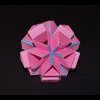
Geometric Forms and Polyhedra
Making polyhedra using strips of paper is also relatively popular. People who enjoy modular origami will also enjoy this type of strip folding since both will produce similar kinds of models. There are two ways to make polyhedra from strips of paper: snapology and knotology – both were developed by Heinz Strobl.
- Snapology: The term snapology was coined by Heinz Strobl and it involves cutting numerous strips of paper. One set of strips are folded into triangular prisms (these are the units or modules). The second set of strips are folded into snaps (connectors). Geometric forms are assembled by using the snaps to connect the units together.
Snapology is relatively easy to do and you can make a variety of polyhedra and other geometric shapes.
- get snapology instructions (H Rosciszewska-Narloch)
- make a snapology egg (make-origami.com)
more photos by G Bubniak and H Rosciszewska-Narloch - see elaborate models made by Heinz Strobl here (Tina) and here (H Rosciszewska-Narloch)
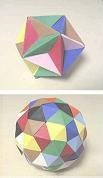
Later, knotology evolved to include models that were based on equilateral & isosceles triangles which are not knotted; however, the term knotology stayed.
In knotology, the strips of paper are creased to have a regular pattern such as a strip of squares, isosceles triangles, or quadrilaterals. The strips are then layered on one another and then weaved & plaited to make a model that is stable without the use of glue or tape. [Photos by J Blowers; strips are folded into quadrilaterals and then woven into “Starboss” and “Geodesic”.]
- make Star Margarete (W Moller)
- cuboctahedron tutorial: pg 1 , 2 (D Severova)
- make sphere94: a pentagon-knot polyhedra (H Strobl)
- read knotology projects (P Versnick)
- read strip folding instructions & theory (H. B. Meyer)
More Examples of Strip Folding
In addition to the above, there are a few other models made with strips of paper.
Noteworthy are the traditional models of fish, bird, and grasshopper. These models have been around for a long time and can be made with paper, ribbon or with palm leaves. [Top: Traditional Ribbon Fish by V Ko. Bottom: Easy Ribbon Fish].
- traditional ribbon fish here, here and here
- easy ribbon fish photo instructions here
- learn to fold a Lucky Heart (ORC)
- instructions for trigonal bipyramid (ORC)
- instructions for a finger ring
- instructions for Wobbling Wall of Cubes (Heinz Strobl) (video)
- instructions for Soma Cube puzzle hereand here (S Kirsch)
- instructions for Flexicube (P Noble)
Some creative and talented folders can do a lot with a strip of paper. For example, Cheng Chit Leong uses a strip that is 1 x 22 to make the Cycle of Life
. It is a dynamic model and is described as:
“Youth, adulthood, and self-actualization”.
- Read about palm weaving here
See paper weaving projects for kids:
- Make a woven heart basket (ORC)
- Make a Woven Fish with glue/cutting (ORC)
- Make a Loopy Heart (ORC)
- Make a Woven Place Mat (ORC)
- Make a Zig-zag Woven Mat (ORC)
